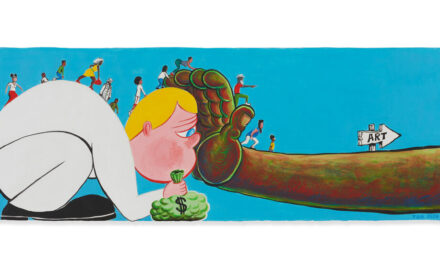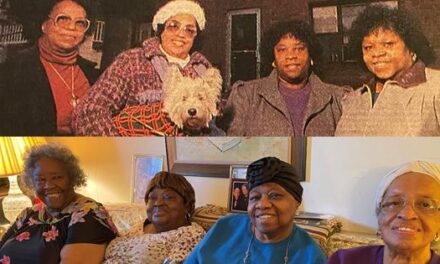Art
Ayanna Dozier
Jun 27, 2023 8:28PM
Queer life and the mainstream art world have not always co-existed seamlessly. In an interview with The Paris Review, legendary cultural critic Douglas Crimp described the clear demarcations of the 1970s, 1980s, and 1990s, about how much of an artist’s queer life should bleed through into their work. “The main compartmentalization was that I had my gay world and I had my art world,” he said. In his work, Crimp argues that the border between the art world and, larger, queer life was only broken by artists’ sheer determination. In other words, today, the mainstream art world’s embrace of more open examinations of queer life (seen in the work of artists like Oscar yi Hou, Justin Yoon, Naima Green, and Devan Shimoyama) is a contemporary phenomenon.
Take, for example, the national backlash and lack of larger art world support for the 1989 exhibition “Witness: Against Our Vanishing,” curated by Nan Goldin at Artists Space in Lower Manhattan. That group exhibition, featuring work by Peter Hujar, David Wojnarowicz, Kiki Smith, and others, had its National Endowment Arts funds stripped because of the artists’ explicit work on AIDS and its criticism of the national response to the medical emergency.
Advertisement
Today, many younger queer artists and curators are amplifying the work of their predecessors to create an intergenerational narrative of artistic exchange, as well as a genealogy through which we might read their work.
As Pride month comes to an end, Artsy has gathered seven LGBTQIA+ artists working across the 1980s and 1990s whose pioneering work have paved the way for emerging queer artists today.
B. 1964, San Francisco. Lives and works in Los Angeles and Joshua Tree.
Multidisciplinary artist Julie Tolentino will be familiar to many from the work of AIDS activist collective Gran Fury. In their poster Kissing Doesn’t Kill: Greed and Indifference Do, made with Lola Flash, the two femmes with their heads shaved at the side are photographed playfully kissing one another with tongues visible. The work is emblematic of Tolentino’s rich practice as both a sexuality educator and performance artist, using the aesthetics of eroticism and activism through image and text across their work, which uses performance, play, dance, and media.
In the 1990s, Tolentino worked with Madonna on her infamous book SEX (recently re-published by Saint Laurent last year following its pop-up exhibition during Art Basel in Miami Beach). Along with performance artist Jaguar Mary X, they also founded the legendary lesbian bar the Clit Club, which was open from 1990 to 2002. Tolentino received their MFA in experimental choreography from the University of California, Riverside, in 2020. Tolentino is currently a faculty member at the California Institute of the Arts.
B. 1939, Washington, D.C. Lives and works in Asheville, North Carolina.
Clarissa Sligh is a Black American artist who is known for her photographs, artist’s books, and installations. Her work often explores themes of identity and family life, based on her personal experience: She was notably one of the plaintiffs in the 1955 landmark school desegregation case in Virginia.
Working across printmaking and photography, Sligh uses the medium of the photobook to document queer and trans lives. Sligh creates a kind of visual diary, characterized by its use of handwritten text and archival images of Black women, that navigates both personal and collective memory.
Sligh’s work has received renewed acclaim in the art world over the past few years. Earlier this year, she was featured in the group exhibition “The Embodied Press: Queer Abstraction and the Artist Book” at the Centre for Craft, Nova Scotia. More recently, she is one of 70 artists featured in New York–based Candice Madey’s dynamic group exhibition “Luxe, Calme, Volupté,” on view through August 11th, focusing on work from 1980s New York.
B. 1945, Brooklyn. Lives and works in New York.
Stanley Stellar’s photographs have cemented into history the queer communities that grew and flourished in the West Village piers in New York. These incredible black-and-white photographs were often taken in public spaces, such as parks, beaches, and streets, and documented moments of relaxation, intimacy, and play.
These historical images function like a time capsule, reflecting a cruising culture that is no longer visually present in this area, due to rampant gentrification and the destruction of the piers. With a younger generation of artists working with intimacy and cruising in their photographic projects, like Camilo Godoy and Jorge Sánchez (their exhibition “Amigxs Radicales” is on view through July 23rd at The Clemente in New York), Stellar’s work serves as a historical blueprint. Stellar is represented by Kapp Kapp, which featured his work as part of its standout booth at Independent New York earlier this year.
B. 1964, Boston. Lives and works in New York.
Pamela Sneed’s vivid and sensuous poetry challenges social injustice at the intersection of race, gender, and sexuality. But beyond poetry, the multidisciplinary artist also uses performance, photography, and painting to create confrontational encounters in which audiences can recognize and interrogate their prejudices and biases. For instance, Sneed’s watercolor and collaged portraits honor forgotten lesbian histories, memorializing them for the future.
These works can be seen in the current exhibition “The Breaking Room,” a group show on view through July 8th at New York–based Kates-Ferri Projects. In this show, Sneed pays homage to overlooked Black queer legacies through watercolor portraits of such Blues musicians as Gertrude “Ma” Rainey, Moms Mabley, Bessie Smith, and Big Mama Thornton. Her 2020 poetic memoir Funeral Diva won the Lambda Award for Lesbian Poetry. She recently collaborated with Coco Fusco for her installation film Your Eyes Will Be an Empty Word (2021) at the 2022 Whitney Biennial, “Quiet as It’s Kept.”
B. 1963, New York. Lives and works in New York.
Cary Leibowitz’s ceramics and paintings use humor and craft to create blunt commentaries on his experience as a gay Jewish man. Leibowitz, who often works under the name Candy Ass, creates vivid and colorful work that is often described as abject—both self-loathing and reflexive towards his lived experience.
Juxtaposing appropriated text and his own with found images and symbols, Leibowitz’s work confronts audiences by “outing” himself as pathetic, using derogatory remarks to claim his space. In doing so, Leibowitz faces the underbelly of anti-Semitism and homophobia that still lurks in society head-on.
The artist’s colorful persona frequently pops up in his work, in its autobiographical content that employs his distinctive sense of humor. Leibowitz’s art narrates his relationship to both his practice and the art world at large, which includes commenting on his second job in the art market as co-head of editions at Phillips auction house, where he co-founded the prints department in 2008.
B. 1962, Los Angeles. Lives and works in New York.
In his prints and sculptures, Adam Rolston uses humor and appropriation to index queerness in his work, while also drawing attention to its absence in mainstream culture. For example, his influential 1991 sculpture Trojans Box features a faux warehouse cardboard box that the artist fabricated, printed with realistic-seeming branding as well as the description “for your protection during anal and vaginal sex.” This literal labeling of objects featured in his work and their titles may appear obvious. However, Rolston’s work draws attention to the slippery role that categories play in determining one’s sexuality and visibility in society.
In Trojans Box, Rolston also used the interplay between text and object as a way to advocate for demands for safer sex during the height of the AIDS/HIV pandemic in the early 1990s. Yet the sculpture also critiques the inherent homophobia of these demands: Condoms, seen as shameful secrets, were shipped in sealed plastic bags rather than boxes, like the fake one he fabricated. For Rolston, combining text and object into sculpture exposes how structural issues become personal problems to resolve in society, not unlike the work of Barbara Kruger, whose work he riffed on in I Am Out Therefore I Am (1989). Like Sligh and Leibowitz, Rolston’s work can be seen in “Luxe, Calme, Volupté.”
B. 1939, Los Angeles. D. 2019, New York.
Though she is the only deceased artist on this list, Barbara Hammer has had an impact that can’t be overstated. The filmmaker worked across film and photography to center lesbian representation in an era where queer art was dominated by gay men.
Hammer’s early films were often short and experimental, and she used a variety of techniques, such as collage, superimposition, and slow motion, to present explicit images of lesbian sex. By manipulating formal techniques in photography and film, Hammer sought not to represent lesbian histories figuratively, but rather to convey what those entanglements feel like on a somatic level. Towards the end of her life, Hammer began to boldly confront aging in her work and documented her experience with ovarian cancer, for example in her 2018 performance lecture “The Art of Dying.” Her estate is represented by Company Gallery.
Ayanna Dozier
Ayanna Dozier is Artsy’s Staff Writer.
Correction: An earlier version misattributed Pamela Sneed as part of Kates-Ferri Projects’s artist roster.



